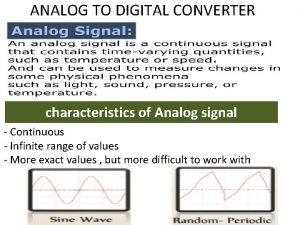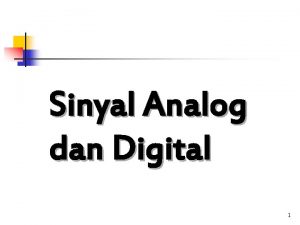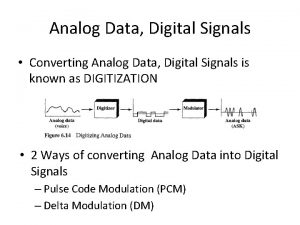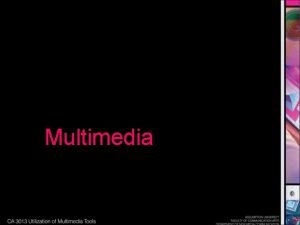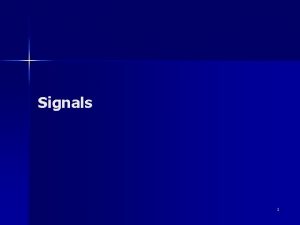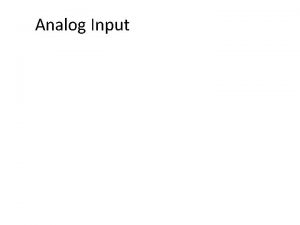FCC Required Technical Standards for Analog Digital Signals










- Slides: 10

FCC Required Technical Standards for Analog & Digital Signals Robert Schaeffer, President Technology Planners, LLC robert. schaeffer@techplanners. com SCTE IEEE Senior Consultant to NCTC Cable TV Pioneers

Did you know that there are technical standards that RF MVPD systems are required to meet? Does your system architecture make a difference? No Yes • The rules do not differentiate between coaxial, HFC, FTTH, etc. If you are using RF carriers, you must meet the FCC Technical Standards. • IP to the home systems that do not use RF in any way, would be exempt from some of these proofs. &

47 CFR Part 76 Subpart K—Technical Standards Leakage Monitoring & CLI • All systems operating RF carriers in aeronautical frequencies with power levels of 38. 75 d. Bm. V or greater, must comply with leakage requirements. § 76. 610 Operation in the frequency bands 108 -137 and 225 -400 MHz—scope of application. The provisions are applicable to all MVPDs (cable and non-cable) transmitting carriers or other signal components carried at an average power level equal to or greater than 10− 4 watts across a 25 k. Hz bandwidth in any 160 microsecond period, at any point in the cable distribution system in the frequency bands 108 -137 and 225 -400 MHz for any purpose. § 76. 613 Interference from a multichannel video programming distributor (MVPD). (a) Harmful interference is any emission, radiation or induction which endangers the functioning of services or seriously degrades, obstructs or repeatedly interrupts a radionavigation service or of other safety services (b) An MVPD that causes harmful interference shall promptly take appropriate measures to eliminate the harmful interference.

47 CFR Part 76 Subpart K—Technical Standards § 76. 614 Cable television system regular monitoring. Cable television operators transmitting carriers in the frequency bands 108 -137 and 225 -400 MHz shall provide for a program of regular monitoring for signal leakage by substantially covering the plant every three months. The incorporation of this monitoring program into the daily activities of existing service personnel in the discharge of their normal duties will generally cover all portions of the system and will therefore meet this requirement. Monitoring equipment and procedures utilized by a cable operator shall be adequate to detect a leakage source which produces a field strength in these bands of 20 u. V/m or greater at a distance of 3 meters. During regular monitoring, any leakage source which produces a field strength of 20 u. V/m or greater at a distance of 3 meters in the aeronautical radio frequency bands shall be noted and such leakage sources shall be repaired within a reasonable period of time § 76. 611 Cable television basic signal leakage performance criteria. (a) No cable television system shall commence or provide service in the frequency bands 108 -137 and 225400 MHz unless such systems is in compliance with one of the following cable television basic signal leakage performance criteria: (1) Prior to carriage of signals in the aeronautical radio bands and at least once each calendar year, with no more than 12 months between successive tests thereafter, based on a sampling of at least 75% of the cable strand, and including any portion of the cable system which are known to have or can reasonably be expected to have less leakage integrity than the average of the system, the cable operator demonstrates compliance with a cumulative signal leakage index by showing either that (i) 10 log I 3000 is equal to or less than − 7 or (ii) 10 log I 00 is equal to or less than 64, using one of the following formula: Note: (i) Flyover formula, (ii) Ground formula

47 CFR Part 76 Subpart K—Technical Standards Required Periodic Testing • All systems with 1000 or more subscribers are required to demonstrate proof of performance for the technical standards. § 76. 601 Performance tests. (a) The operator of each cable television system shall be responsible for insuring that each such system is designed, installed, and operated in a manner that fully complies with the provisions of this subpart. (b) The operator of each cable television system shall conduct complete performance tests of that system at least twice each calendar year (at intervals not to exceed seven months), unless otherwise noted below. The performance tests shall be directed at determining the extent to which the system complies with all the technical standards set forth in § 76. 605(a) and shall be as follows: § 76. 605 Technical standards. a) The following requirements apply to the performance of a cable television system as measured at any subscriber terminal with a matched impedance at the termination point or at the output of the modulating or processing equipment (generally the headend) of the cable television system or otherwise as noted. The requirements are applicable to each NTSC or similar video downstream cable television channel in the system:

47 CFR Part 76 Subpart K—Technical Standards Digital Cable Systems • All systems utilizing QAM modulation and have an activated channel capacity greater than 750 MHz must also meet the digital cable system standards. § 76. 640 Support for unidirectional digital cable products on digital cable systems. (a) The requirements of this section shall apply to digital cable systems. For purposes of this section, digital cable systems shall be defined as a cable system with one or more channels utilizing QAM modulation for transporting programs and services from its headend to receiving devices. Cable systems that only pass through 8 VSB broadcast signals shall not be considered digital cable systems. (b) (1) Digital cable systems with an activated channel capacity of 750 MHz or greater shall comply with the following technical standards and requirements:

A Summary of Testing Requirements; § 76. 610 -11 All systems operating RF carriers in aeronautical frequencies with power levels of 38. 75 d. Bm. V or greater, must comply with leakage requirements. § 76. 605 All systems with 1000 or more subscribers are required to demonstrate proof of performance of the technical standards. § 76. 640 All systems utilizing QAM modulation and have an activated channel capacity greater than 750 MHz must also meet the digital cable system standards.

What happens if we don't pass? Given the complexity of today's cable systems, the thousands of mechanical connections involved and the growing number of active and passive signal pathways; something, somewhere, is likely to be broken at any given point in time. The most important thing is to run the tests, find the problems, enact timely repair, and document the process.

Benefits of a third party analysis; Time productivity for local staff Third party support under FCC audit Fresh perspective on system performance Opportunity to discuss improvement ideas

 Analog and digital signals in computer networking
Analog and digital signals in computer networking Digital data digital signals
Digital data digital signals Digital data transmission
Digital data transmission Characteristics of analog signals
Characteristics of analog signals Sinyal periodik
Sinyal periodik Animals and human language chapter 2
Animals and human language chapter 2 Arbitrariness in human language and animal language
Arbitrariness in human language and animal language Communicative and informative signals
Communicative and informative signals Svenskt ramverk för digital samverkan
Svenskt ramverk för digital samverkan Compare and contrast analog and digital forecasting
Compare and contrast analog and digital forecasting Pengertian teknologi digital dan analog
Pengertian teknologi digital dan analog



